Our 298-lb California model weighs just one pound more than the 49-state version, and with its lights, turn signals and license plate, made riding to the trails and then hitting it a fairly do-able proposition.
We’d estimate this is about a 60:40 bike in terms of its street/offroad prowess, and changing the tires to full-on knobbies would make it about a 50:50.
If you’re more an on-road person, you may also want to look at the WR250R’s supermoto-style sister, the WR250X, which differs mainly by use of 17-inch wheels, sport tires, larger front brake, slightly taller gearing, and different graphics. Both of these bikes were extensively reviewed when they were launched, and you can get more tech details and riding anecdotes here.
Street Riding Impressions
We dyno’d the same-engined 250X model last year, and its oversquare, 11.8:1 compression ratio powerplant returned 27.7 hp and 16.95 ft-lbs torque. Combined with its wide-ratio six-speed transmission this is enough to stay ahead of traffic around town. It will easily wheelie in first, and second gear with a little clutch slip.
On the open road, with a 200-lb rider geared up and acting like a sail, it will still pull just shy of 90 mph into mild headwinds, and up to around 95 mph or so when tucked in, which is enough power even if traveling via interstate highways.
If desired, this bike could be pressed into duty as an ultra-lightweight adventure tourer, at least for several hundred miles, if not longer, depending on your needs and tolerance – particularly if much of your route is on secondary roads and off road.
Handling from the 55.9-inch wheelbase machine is stable enough at speed, yet light and nimble around town. Riding on 18-inch rear and 21-inch front wheels, the Bridgestone Trail Wing TW-301 front and TW-302 rear tires have adequate grip on tarmac. The 46mm, 10.6-inch-travel KYB fork, coupled with Soqi shock offering equal travel in the rear, soak up expansion joints and potholes with aplomb.
Slowing down the action is easy enough with a single 250mm disc brake up front, and 230mm rear disc.
The bike comes rather softly set up for street duties, but front and rear suspenders have provision for spring preload, as well as compression and rebound damping adjustments – items lacking on less-expensive Japanese competitors.
Off-Road Riding Impressions
The WR250R is close to being the proverbial “dirtbike with lights,” but alas, the component spec, including the street-legalizing extras make it 42 lbs heavier than the longer-travel WR250F enduro, so we have no illusions there.
A stiff asymmetrical swingarm, cast aluminum cross members, and a 22mm rear axle also help keep things in line and combine with obvious work done toward achieving mass centralization.
In short, the WR250F hides its extra pounds well, and handles gravel and dirt roads, mud, grass, and loose dirt and rocks reasonably well. Its long suspension lets you plow over 6-inch or larger rocks, and soak up square-edge holes that would have lesser bikes destabilized.
In the high mountain desert in and around El Mirage, the bike showed itself at least able to hold its own. The only sketchy part was when hitting deep, loose sand. Bikes with true desert tires we rode with could stay on line much better, whereas the closer knob pattern on the Yamaha’s on/off-road compromise tires often had more than they could handle.
Hitting deep, rutted sand washes at anywhere from 20-40 mph, we sort of had to just hold on and keep the bike upright, staying mindful of body positioning, trying not to nail something that could affect steering. Several times we would get channeled by the rivulet-marked surface we were floating through, started to plow the front sideways and wondered whether we would recover. Fortunately we did, but it did not encourage us to fly like banshees through the open scrub environment like guys on better-equipped dirtbikes could.
Conclusion
As an all-arounder, this bike is terrific. Under mixed use, it returned close to its estimated average 71 mpg, and only slowly sipped from its 1.9-gallon fuel tank (2.0 gallons for 49-state models). We would have liked a tachometer to see how close it was to its 11,500-rpm redline.
But the sophisticated engine and chassis are solid performers, and will take you darn near anywhere any vehicle is capable of going. For $6,490, it offers a lot of utility and fun in a manageable package, with potential to be modified if desired, to offer even more.
|
We’d estimate this is about a 60:40 bike in terms of its street/offroad prowess, and changing the tires to full-on knobbies would make it about a 50:50.
If you’re more an on-road person, you may also want to look at the WR250R’s supermoto-style sister, the WR250X, which differs mainly by use of 17-inch wheels, sport tires, larger front brake, slightly taller gearing, and different graphics. Both of these bikes were extensively reviewed when they were launched, and you can get more tech details and riding anecdotes here.
Sparse instrumentation includes trip, speed, clock and stopwatch info but could benefit from a fuel gauge and tach. |
Street Riding Impressions
 |
| Top 2013 Yamaha WR250R Review |
As a jack of all trades, master of none, it is really quite capable. It gets 71 mpg, handles street and trail, all for around $6500. Not bad if you only have to have one bike, with a bias toward tackling frequent offroad forays.
The WR250R’s fuel-injected, 4-valve-per-cylinder mill churns out respectable go-power, even with relatively lean, EPA-satisfying tuning and three-chamber muffler. When cold especially, it displayed a slight off-idle stumble at times, but this is something that could be tuned out.We dyno’d the same-engined 250X model last year, and its oversquare, 11.8:1 compression ratio powerplant returned 27.7 hp and 16.95 ft-lbs torque. Combined with its wide-ratio six-speed transmission this is enough to stay ahead of traffic around town. It will easily wheelie in first, and second gear with a little clutch slip.
On the open road, with a 200-lb rider geared up and acting like a sail, it will still pull just shy of 90 mph into mild headwinds, and up to around 95 mph or so when tucked in, which is enough power even if traveling via interstate highways.
If desired, this bike could be pressed into duty as an ultra-lightweight adventure tourer, at least for several hundred miles, if not longer, depending on your needs and tolerance – particularly if much of your route is on secondary roads and off road.
Handling from the 55.9-inch wheelbase machine is stable enough at speed, yet light and nimble around town. Riding on 18-inch rear and 21-inch front wheels, the Bridgestone Trail Wing TW-301 front and TW-302 rear tires have adequate grip on tarmac. The 46mm, 10.6-inch-travel KYB fork, coupled with Soqi shock offering equal travel in the rear, soak up expansion joints and potholes with aplomb.
The lightweight dual-sport comports itself well in a variety of environments. |
Slowing down the action is easy enough with a single 250mm disc brake up front, and 230mm rear disc.
 |
| Top 2013 Yamaha WR250R Review |
The 21-inch front on/off-road knobby is stopped by a single-piston caliper squeezing a 250mm slotted wave rotor.
Passenger pegs make it possible to carry someone at least moderate distances, and, if desired, the stock 36.6-inch ride height can be shortened by nearly an inch by means of a shock-linkage-mounted clevis pin arrangement. While sitting on the bike, normal sag under my 185 lbs dropped the ride height so I could just plant both feet flat beneath my 34-inch inseam. The bike comes rather softly set up for street duties, but front and rear suspenders have provision for spring preload, as well as compression and rebound damping adjustments – items lacking on less-expensive Japanese competitors.
Off-Road Riding Impressions
The WR250R is close to being the proverbial “dirtbike with lights,” but alas, the component spec, including the street-legalizing extras make it 42 lbs heavier than the longer-travel WR250F enduro, so we have no illusions there.
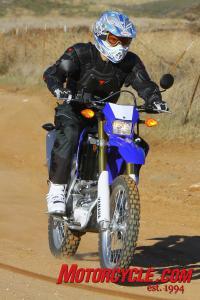 |
| Top 2013 Yamaha WR250R Review |
The WR250R makes light work of dirt roads, and also handles woops, small jumps, and most loose terrain. Thanks to Bell for the Moto-8 helmet, Dainese for the Wave Pro V CE Level 2 armored jacket, Klim for the Dakar gloves and pants, and A-stars for the Tech 8 boots.
This said, Yamaha has surely done its homework on the WR250R to make it as capable in the loose stuff as possible. The semi-double-cradle frame uses cast and forged aluminum sections to comprise the main frame, and steel downtubes reinforce the structure, adding up to good rigidity.A stiff asymmetrical swingarm, cast aluminum cross members, and a 22mm rear axle also help keep things in line and combine with obvious work done toward achieving mass centralization.
In short, the WR250F hides its extra pounds well, and handles gravel and dirt roads, mud, grass, and loose dirt and rocks reasonably well. Its long suspension lets you plow over 6-inch or larger rocks, and soak up square-edge holes that would have lesser bikes destabilized.
In the high mountain desert in and around El Mirage, the bike showed itself at least able to hold its own. The only sketchy part was when hitting deep, loose sand. Bikes with true desert tires we rode with could stay on line much better, whereas the closer knob pattern on the Yamaha’s on/off-road compromise tires often had more than they could handle.
Hitting deep, rutted sand washes at anywhere from 20-40 mph, we sort of had to just hold on and keep the bike upright, staying mindful of body positioning, trying not to nail something that could affect steering. Several times we would get channeled by the rivulet-marked surface we were floating through, started to plow the front sideways and wondered whether we would recover. Fortunately we did, but it did not encourage us to fly like banshees through the open scrub environment like guys on better-equipped dirtbikes could.
As a reference point, I tried to keep up with my buddy Mark Mamone on his 2002 KTM 520 with its dialed suspension and Dunlop desert tires. It wasn’t much of a race, but the Yamaha at least was not completely out of its element. Better tires and suspension adjustments would have helped it substantially. |
Conclusion
As an all-arounder, this bike is terrific. Under mixed use, it returned close to its estimated average 71 mpg, and only slowly sipped from its 1.9-gallon fuel tank (2.0 gallons for 49-state models). We would have liked a tachometer to see how close it was to its 11,500-rpm redline.
Thanks also to Klim for the F4 helmet, Chinook pants, Revolt jersey, and Shift for the Vertex gloves. |
But the sophisticated engine and chassis are solid performers, and will take you darn near anywhere any vehicle is capable of going. For $6,490, it offers a lot of utility and fun in a manageable package, with potential to be modified if desired, to offer even more.

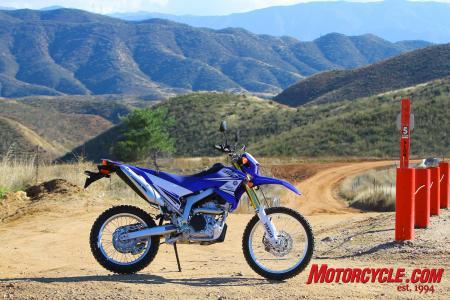
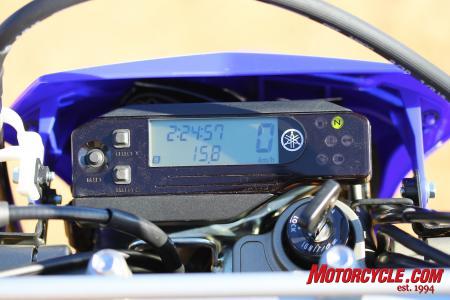
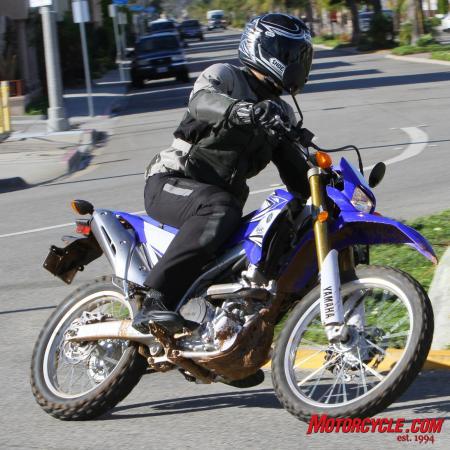
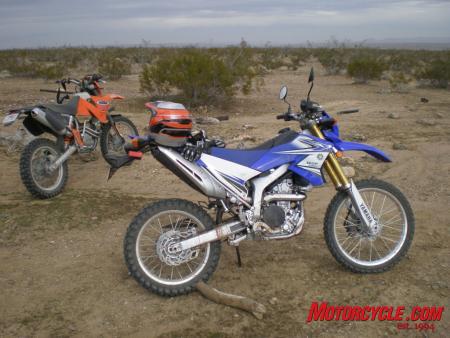

Thanks for sharing such informative post regarding Yamaha WR250R. I think you forget to mention that there are number of incredible Yamaha WR250R Repairing and Servicing Manuals available out there, which provides all the information regarding repairing and servicing of Wr250R with the help of diagrams.
ReplyDelete